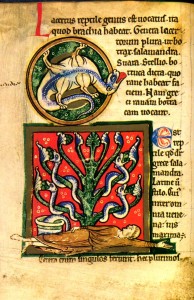
Salamandra /salamandra/ height 7.7 cm, width at the bottom 9.1 cm, width at the top 7.6 cm
The enigmatic salamandra, which does not burn in fire, is the most poisonous of all creatures. Its poison penetrates into growing fruits and contaminates water. Upon eating a fruit from a tree poisoned by the salamandra a man dies.
The story of the salamandra living in fire had come from remote antiquity. It is mentioned by Aristotle /V.552, b 16/. Pliny adds to the story the knowledge about the salamandra’s venomousness and its ice-cold blood /XXIX.4.23; X.67.86/. His narrarion was used by Isidor /XII.4.36/, and later by Pseudo Hugh /11.16/ and in the bestiaries. The “Physiologus” mentions the salamandra’s ability to put out fire and compares it with three pious adolescents who did not burn in a fiery oven. Version “B” joins the story of the salamandra with the characteristic of the spotted snake /stellio/ drawing on the Holy Writ sacred writings: “Sicut stellio habitans in domus regum” /Prov. 30:28/. Guillaume le Clerk also compares the sala-manda with a righteous man /2737—2822/. Albert the Great discusses varios views of the salamandra referring to Pliny, Solinus, Galien, Jorah, and Aristotle /XXV.II.46/. Pierre of Beauvais tells of the magic cloth, made of salamandra skin, which does not burn in fire and is cleaned by fire rather than water /III.271/. In the later medieval and alchemistic symbolics the salamandra comes to signify one of the four elements — fire.
The painter of the miniature featuring the salamandra reproduced the traditional ornamental design of a tree with the stylized leaves of acanthus used in medieval art to draw heraldic and hierarchic compositions.
Salamandra
by
Tags:
Leave a Reply